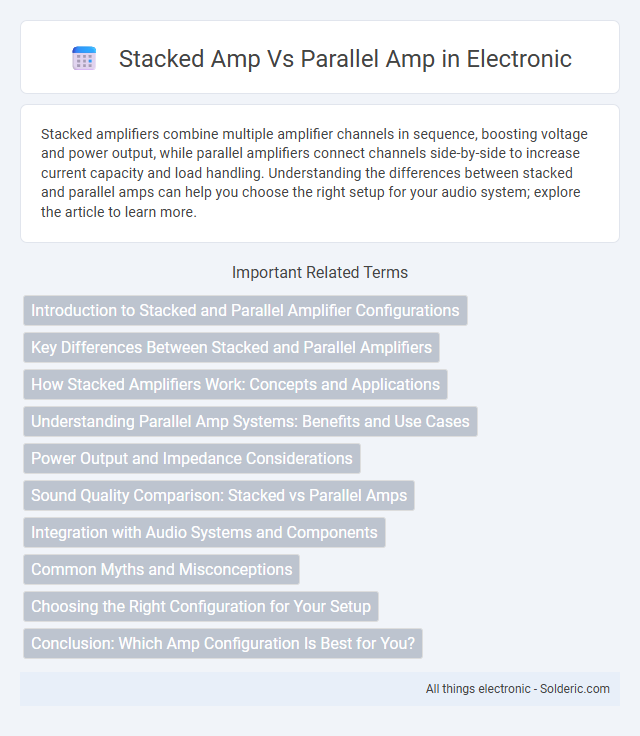Stacked amplifiers combine multiple amplifier channels in sequence, boosting voltage and power output, while parallel amplifiers connect channels side-by-side to increase current capacity and load handling. Understanding the differences between stacked and parallel amps can help you choose the right setup for your audio system; explore the article to learn more.
Comparison Table
| Feature | Stacked Amplifier | Parallel Amplifier |
|---|---|---|
| Configuration | Amplifiers connected in series | Amplifiers connected side-by-side (parallel) |
| Output Voltage | Higher output voltage (sum of voltages) | Same voltage as individual amplifiers |
| Output Current | Current same as single amplifier | Higher output current (sum of currents) |
| Power Handling | Better for high voltage applications | Better for high current applications |
| Complexity | Requires precise voltage matching | Requires current sharing mechanisms |
| Thermal Management | Thermal stress can concentrate on series devices | Heat spread across parallel devices |
| Applications | High-voltage amplification, RF power stages | Audio amplifiers, power amplifiers needing high current |
Introduction to Stacked and Parallel Amplifier Configurations
Stacked amplifier configurations arrange multiple amplifier stages vertically to increase power output by combining their gains, while parallel amplifier configurations connect amplifiers side-by-side to share the load and improve current handling capacity. Understanding these setups helps optimize your audio system for power efficiency and sound quality. Choosing between stacked and parallel amps depends on your specific power requirements and desired performance metrics.
Key Differences Between Stacked and Parallel Amplifiers
Stacked amplifiers arrange multiple amplifier stages in series, boosting signal gain by passing the output of one stage directly into the next, while parallel amplifiers split the input signal across multiple identical stages and combine their outputs to increase power handling and reduce distortion. Stacked configurations excel in applications requiring high voltage amplification, whereas parallel amplifiers are preferred for high current output and improved thermal management. You can optimize your audio system by selecting stacked amps for voltage gain needs or parallel amps for enhanced power delivery and reliability.
How Stacked Amplifiers Work: Concepts and Applications
Stacked amplifiers work by vertically integrating multiple amplifier units, each boosting the signal sequentially to increase overall gain without significantly raising noise levels. This configuration enhances signal strength and clarity, making it ideal for applications requiring high power and efficient signal amplification such as telecommunications and audio systems. Your system benefits from improved linearity and reduced distortion, optimizing performance in complex signal environments.
Understanding Parallel Amp Systems: Benefits and Use Cases
Parallel amp systems amplify audio signals through multiple channels operating simultaneously, providing increased power output without compromising sound quality. These amps efficiently distribute load, reduce distortion, and ensure improved overall performance in high-demand applications such as large venue sound reinforcement and complex multi-speaker setups. Key benefits include enhanced reliability, scalability, and optimal thermal management, making parallel amplifiers ideal for professional audio installations and concert environments.
Power Output and Impedance Considerations
Stacked amps combine power output by connecting multiple amplifier modules in series, increasing impedance and allowing higher wattage delivery suitable for high-power applications. Parallel amps divide the load across amplifier channels, maintaining lower impedance and providing greater power efficiency with improved thermal management. Understanding impedance matching is crucial to prevent power loss and ensure optimal amplifier performance in both stacked and parallel configurations.
Sound Quality Comparison: Stacked vs Parallel Amps
Stacked amplifiers typically offer richer sound quality with enhanced depth and warmth due to their series configuration, which allows the signal to pass through multiple stages, amplifying nuances and detail. Parallel amps deliver cleaner, more transparent audio by simultaneously processing the input signal, preserving clarity and minimizing distortion, especially at higher volumes. Audiophiles often favor stacked amps for a fuller, more textured sound, while parallel amps suit those seeking crisp, precise audio reproduction.
Integration with Audio Systems and Components
Stacked amplifiers offer enhanced integration with complex audio systems by providing separate preamp and power amp sections, allowing for greater customization and flexibility in signal routing and component matching. Parallel amplifiers simplify integration by delivering combined amplification within a single chassis, reducing wiring complexity and space requirements, which benefits compact or streamlined setups. Both configurations support effective connectivity with standard audio components, but stacked amps excel in modular environments where individual component optimization is critical.
Common Myths and Misconceptions
Stacked amplifiers are often mistaken for simply more powerful versions of parallel amplifiers, but they fundamentally differ in signal flow and output characteristics. A common misconception is that parallel amps waste power, whereas both configurations have efficiency depending on design and application. Many believe stacked amps always produce superior sound quality, yet the optimal choice depends on the system's integration and intended use rather than inherent amplifier arrangement.
Choosing the Right Configuration for Your Setup
Choosing between a stacked amp and a parallel amp depends on your audio setup's power requirements and space constraints. A stacked amp configuration offers higher power output by connecting amplifiers in series, ideal for driving multiple speakers with maximum volume, while parallel amps distribute power evenly, reducing strain and improving reliability for balanced setups. Understanding your system's impedance and wattage needs ensures you select the configuration that optimizes performance and protects your equipment.
Conclusion: Which Amp Configuration Is Best for You?
Stacked amps offer higher power output and better load handling, making them ideal for large venues or bass-heavy setups. Parallel amps provide cleaner signal paths with less distortion, suitable for studio environments or precise tonal control. Your choice depends on whether you prioritize raw power or signal clarity for your specific audio needs.
Stacked amp vs Parallel amp Infographic

 solderic.com
solderic.com